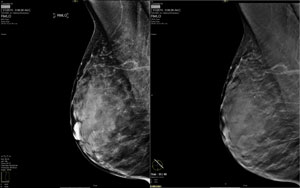Time Magazine Highlights Digital Breast Tomosynthesis as One of the Leading Health Advances in 2014
User of Carestream’s DBT Technology Advocates DBT for Reading of All Screening Mammograms
ROCHESTER, N.Y., Jan. 20 — Time Magazine cast a spotlight on the dramatic impact of digital breast tomosynthesis in detecting cancers (particularly in women with dense breasts) in its article entitled “11 Remarkable Health Advances from 2014.” A separate Time article reports that women with dense breasts carry a greater risk for cancer and also have tumors that are more difficult to detect. That article also presents the results of a scientific study presented at the 2014 annual meeting of the Radiological Society of North America (RSNA) in December that involved more than 25,500 women between ages 50 and 69.
The study found that combining DBT with full-field digital mammography images detected many more cancers than FFDM alone: 211 cancers compared to only 163. When it came to dense breasts, the combined use of DBT and FFDM were able to identify 80% of the cancers, versus 59% when FFDM was used alone.
“There have been multiple scientific studies documenting the value of DBT technology in enhancing detection rates for breast cancer. We believe that the radiology and mammography communities recognize the value it offers for both screening and diagnostic mammograms,” said Ron Muscosky, Carestream’s Worldwide Product Line Manager for Healthcare Information Solutions.
 Carestream offers an advanced digital breast tomosynthesis (DBT) module that is accessible from its CARESTREAM Vue Mammo Workstation and Vue PACS. Dr. Harmindar Gill, Medical Director of Premier Women’s Radiology (Bonita Springs, Fla.), uses Carestream’s DBT technology on a Vue Mammo Workstation and is an avid proponent of DBT because she believes it can assist in the effort to further reduce deaths from breast cancer.
Carestream offers an advanced digital breast tomosynthesis (DBT) module that is accessible from its CARESTREAM Vue Mammo Workstation and Vue PACS. Dr. Harmindar Gill, Medical Director of Premier Women’s Radiology (Bonita Springs, Fla.), uses Carestream’s DBT technology on a Vue Mammo Workstation and is an avid proponent of DBT because she believes it can assist in the effort to further reduce deaths from breast cancer.
“DBT produces three-dimensional images that offer significantly enhanced visualization of breast tissue. As a result of my personal experience using DBT and the scientific studies now available, I advocate use of DBT for all screening mammograms—especially for patients with dense breasts, patients with BRCA gene mutation and those who have been previously diagnosed with breast cancer,” she said.
Carestream’s DBT module adds advanced workflow capabilities and specialized tools that can optimize the reading of digital breast tomosynthesis exams at the same time as other procedures. The company’s new slabbing tool combines slices of a DBT series, while allowing the user to choose different rendition modes and slab thicknesses. In scientific studies, radiologists have reported that this capability can help visualize calcifications and decrease reading time. The generation of 2D synthetic views is an alternate approach to acquiring conventional 2D mammography views, which can help reduce the radiation dosage a patient is exposed to while allowing full advantage of the benefits of digital breast tomosynthesis.
Healthcare providers worldwide use Carestream’s Vue PACS and mammography reading tools for reading of routine screening mammograms as well as diagnostic mammography exams. Carestream’s Vue Mammo workstation allows reading of traditional mammograms, breast ultrasound, breast MRI, DBT or general radiography exams from a single desktop.